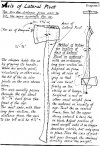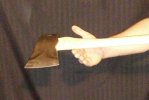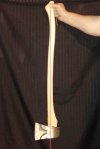Today I pulled the trigger after checking out a few axes at one of our most known "axe/knife/razor" stores in our country.
The guy showing me around explained to me that from all the axes this would probably fit my needs the most and this is also what I understood when watching several reviews/videos of different axes:
Still, I have to say that the GB Scandinavian Forest Axe felt really really great... but he was recommending me the Wetterlings Hudson Bay due to its thicker head which would rather fit my splitting needs than the GB (which would be better for felling soft woods... but then I am most likely only going to fell 1 tree per year).
So here are a few pictures, maybe you can comment on it if I made a good pick?
Axe Handle Grain:
http://files.bestmail.ws/Wetterlings_Hudson_Bay/IMG_20170504_192828.jpg
http://files.bestmail.ws/Wetterlings_Hudson_Bay/IMG_20170504_192824.jpg
http://files.bestmail.ws/Wetterlings_Hudson_Bay/IMG_20170504_193157.jpg
http://files.bestmail.ws/Wetterlings_Hudson_Bay/IMG_20170504_193212.jpg
http://files.bestmail.ws/Wetterlings_Hudson_Bay/IMG_20170504_193316.jpg
http://files.bestmail.ws/Wetterlings_Hudson_Bay/IMG_20170504_193328.jpg
Head & Alignment:
http://files.bestmail.ws/Wetterlings_Hudson_Bay/IMG_20170504_192926.jpg
http://files.bestmail.ws/Wetterlings_Hudson_Bay/IMG_20170504_192849.jpg
http://files.bestmail.ws/Wetterlings_Hudson_Bay/IMG_20170504_200737.jpg
Edge:
http://files.bestmail.ws/Wetterlings_Hudson_Bay/IMG_20170504_192947.jpg
http://files.bestmail.ws/Wetterlings_Hudson_Bay/IMG_20170504_193054.jpg
http://files.bestmail.ws/Wetterlings_Hudson_Bay/IMG_20170504_193113.jpg
Should I worry about this?
http://files.bestmail.ws/Wetterlings_Hudson_Bay/IMG_20170504_193421.jpg
http://files.bestmail.ws/Wetterlings_Hudson_Bay/IMG_20170504_193425.jpg
http://files.bestmail.ws/Wetterlings_Hudson_Bay/IMG_20170504_193434.jpg
Also here are a few questions I am curious about:
1. Is a short handle better for beginners?
2. Should I worry about the balancing point?
3. Should I get 1-2 Wetterlings handles in case one breaks? I might not ever get a chance again to get an original Wetterlings handle?
4. Anything I should do/modify/care about the axe right now to get the most out of it?
Thanks in advance !
The guy showing me around explained to me that from all the axes this would probably fit my needs the most and this is also what I understood when watching several reviews/videos of different axes:
- Allrounder for felling, limbing, chopping and splitting
- Although I will mostly be splitting
- Will only be using a few times a year (do get another stock of firewood for my grandparents / for myself)
Still, I have to say that the GB Scandinavian Forest Axe felt really really great... but he was recommending me the Wetterlings Hudson Bay due to its thicker head which would rather fit my splitting needs than the GB (which would be better for felling soft woods... but then I am most likely only going to fell 1 tree per year).
So here are a few pictures, maybe you can comment on it if I made a good pick?
Axe Handle Grain:
http://files.bestmail.ws/Wetterlings_Hudson_Bay/IMG_20170504_192828.jpg
http://files.bestmail.ws/Wetterlings_Hudson_Bay/IMG_20170504_192824.jpg
http://files.bestmail.ws/Wetterlings_Hudson_Bay/IMG_20170504_193157.jpg
http://files.bestmail.ws/Wetterlings_Hudson_Bay/IMG_20170504_193212.jpg
http://files.bestmail.ws/Wetterlings_Hudson_Bay/IMG_20170504_193316.jpg
http://files.bestmail.ws/Wetterlings_Hudson_Bay/IMG_20170504_193328.jpg
Head & Alignment:
http://files.bestmail.ws/Wetterlings_Hudson_Bay/IMG_20170504_192926.jpg
http://files.bestmail.ws/Wetterlings_Hudson_Bay/IMG_20170504_192849.jpg
http://files.bestmail.ws/Wetterlings_Hudson_Bay/IMG_20170504_200737.jpg
Edge:
http://files.bestmail.ws/Wetterlings_Hudson_Bay/IMG_20170504_192947.jpg
http://files.bestmail.ws/Wetterlings_Hudson_Bay/IMG_20170504_193054.jpg
http://files.bestmail.ws/Wetterlings_Hudson_Bay/IMG_20170504_193113.jpg
Should I worry about this?
http://files.bestmail.ws/Wetterlings_Hudson_Bay/IMG_20170504_193421.jpg
http://files.bestmail.ws/Wetterlings_Hudson_Bay/IMG_20170504_193425.jpg
http://files.bestmail.ws/Wetterlings_Hudson_Bay/IMG_20170504_193434.jpg
Also here are a few questions I am curious about:
1. Is a short handle better for beginners?
2. Should I worry about the balancing point?
3. Should I get 1-2 Wetterlings handles in case one breaks? I might not ever get a chance again to get an original Wetterlings handle?
4. Anything I should do/modify/care about the axe right now to get the most out of it?
Thanks in advance !
Last edited:












